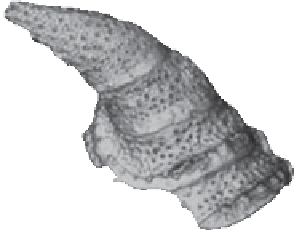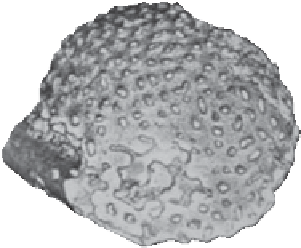Geology Reference
In-Depth Information
?
Ediacaran faunas throughout the world. The trails and burrows
are similar to those made by present-day soft-bodied organisms.
Until recently, it appeared that there was a fairly long
period of time between the extinction of the Ediacaran
fauna and the fi rst Cambrian fossils. That gap has been con-
siderably narrowed in recent years with the discovery of new
Proterozoic fossiliferous localities. Now, Proterozoic fossil as-
semblages continue right to the base of the Cambrian.
Nonetheless, the cause of the sudden appearance of so
many different animal phyla during the Early Cambrian is
still a hotly debated topic. Newly developed molecular tech-
niques that allow evolutionary biologists to compare mo-
lecular sequences of the same gene from different species
are being applied to the phylogeny, or evolutionary history,
of many organisms. In addition, new fossil sites and detailed
stratigraphic studies are shedding light on the early history
and ancestry of the various invertebrate phyla.
The Cambrian explosion probably had its roots fi rmly
planted in the Proterozoic. However, the mechanism or
mechanisms that triggered this event are still being investi-
gated. Although some would argue for a single causal event,
it is more likely that the Cambrian explosion was a combina-
tion of factors, both biological and geological. For example,
geologic evidence indicates that Earth was glaciated one
or more times during the Proterozoic, followed by global
warming during the Cambrian. These global environmental
changes may have stimulated evolution and contributed to
the Cambrian explosion.
Others would argue that a change in the chemistry of
the oceans favored the evolution of a mineralized skeleton.
In this scenario, an increase in the concentration of cal-
cium from the Neoproterozoic through the Early Cambrian
allowed for the precipitation of calcium carbonate and cal-
cium phosphate, compounds that comprise the shells of
most invertebrates.
Another hypothesis gaining favor is that the rapid evolu-
tion of a skeletonized fauna was a response to the evolution
of predators. A shell or mineralized covering would provide
protection against predation by the various predators evolv-
ing during this time.
Another interesting line of research related to the
Cambrian explosion involves
Hox
genes, which are sequen-
ces of genes that control the development of individual
regions of the body. Studies indicate that the basic body
plans for all animals were apparently established by the end
of the Cambrian explosion, and only minor modifi cations
have occurred since then. Whatever the ultimate cause of
the Cambrian explosion, the appearance of a skeletonized
fauna and the rapid diversifi cation of that fauna during the
Early Cambrian were major events in life history.
What Would You Do
Congress has just voted a large cut in funding for the National
Science Foundation (NSF). Because of reduced funding, some
earth science areas will not be funded this year. One area
slated for a major funding reduction or no funding this year is
paleontology. As a paleontology professor whose specialty is
Paleozoic marine ecosystems and whose research depends
on NSF funds, you will be testifying against cutting funding for
paleontology.
What arguments would you use to persuade the members
of Congress to keep funding paleontologic research? What
possible outcomes from your research could you point to that
might benefi t society today?
Cambrian (
Figure 21.1) and the appearance of large skel-
etonized animals during the Cambrian explosion. Along
with the question of why did animals appear so suddenly in
the fossil record is the equally intriguing one of why they
initially acquired skeletons and what selective advantage this
provided. A variety of explanations about why marine or-
ganisms evolved skeletons have been proposed, but none are
completely satisfactory or universally accepted.
The formation of an exoskeleton, or shell, confers ad-
vantages on an organism: (l) it provides protection against
ultraviolet radiation, allowing animals to move into shal-
lower waters; (2) it helps prevent drying out in an intertidal
environment; (3) a supporting skeleton, whether an exoskel-
eton or endoskeleton allows animals to increase their size
and provides attachment sites for muscles; and (4) it pro-
vides protection against predators. Evidence of actual fossils
of predators and specimens of damaged prey, as well as anti-
predatory adaptations in some animals, indicates that the
◗
◗
Figure 21.1
Lower Cambrian Shelly Fossils Two small (several
millimeters in size) Lower Cambrian shelly fossils.
a
Lapworthella
, a conical
sclerite (a piece of armor
covering) from Australia.
The earliest organisms with hard parts are Proterozoic cal-
careous tubes found associated with Ediacaran faunas from
several locations throughout the world. These are followed
by other microscopic skeletonized fossils from the Lower
b
Archaeooides
, an
enigmatic spherical fossil
from the Mackenzie
Mountains, Northwest
Territories, Canada.




Search WWH ::

Custom Search